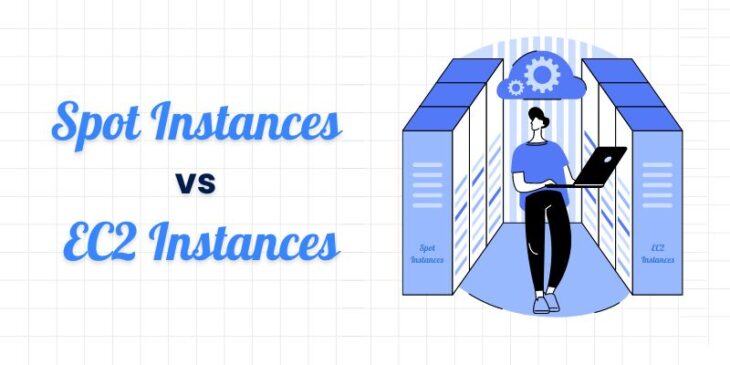
In the vast and dynamic space of cloud computing, decisions concerning computing strategies are vital for organizations seeking optimal performance, scalability and cost-effectiveness. Among many options rendered by AWS, which one to choose between Spot Instances and EC2 Instances is a common dilemma. Each option comes along with a unique set of advantages and considerations that can significantly impact the success of your cloud-based applications and DevOps Engineering Planning to Production implementations.
Here, in this blog, we’re going to discuss Spot Instances and EC2 Instances in detail, exploring the characteristic features and the limitations associated with each of them. Let’s drive in!
Understanding EC2 instances
Amazon Elastic Compute Cloud (EC2) Instances are the elementary building components that enable cloud computing for AWS users. These elements are not just simply scalable and quickly accessible, they offer on-demand, resizable computing capacity in the cloud. Users are free to pick amongst a variety of instance types, which are tailored to specific use cases, for example, compute-optimized, memory-optimized, storage-optimized and more. EC2 Instances are meant for light workloads that are built on stable and predictable architecture, enabling the customers’ applications to be stable and consistent.
What are Spot instances?
The concept of Spot instance is completely new in the cloud computing era. Spot Instance in AWS let users bid for the EC2 instances which are underutilized and eventually cost less. These instances are ideal for workloads that can be interrupted for a period of time or are fault-tolerant. Therefore, users can exploit cost-saving opportunities during periods of excess capacity in the AWS cloud. Spot instance cost-saving techniques and resources play a crucial role in saving costs by cancelling EC2 spot instances available in the AWS zone. However, these come with a condition that they can be pre-terminated by the AWS with a brief notice if the availability of capacity is required for other purposes.
Spot Instances vs EC2 Instances
Choosing between Spot Instances and EC2 Instances is critical for laying a strong foundation of resilient, cost-effective and high-performance cloud infrastructure. With the right approach and prudent understanding of business requirements, enterprises can easily harness the true power of cloud computing. So, let’s read in detail about these differences, here!
Comparing Costs
The cost incurred is one of the important factors that need to be considered while selecting between Spot Instances and EC2 Instances. Spot Instances can be a source of significant cost savings, a reduction of as much as up to 90% when compared to on-demand pricing. Spot instance cost-saving is an important feature that offers great benefits. But this cost-effectiveness comes along with the trade-off of possible inconveniences. EC2 Instances, on the other hand, offer a cost-consistent and calculated pricing model, but may often come at a higher price.
Use Cases
The choice between Spot Instances and EC2 Instances majorly depends on the specific use case and workload characteristics. EC2 Instances could be utilized for applications with fixed needs, mission-critical workloads or scenarios where stability is the prime factor However, the placing of Spot Instances is ideal in situations where cost optimization is of paramount concern and the workloads have built-in flexibility, are tolerant to interruptions or have an automatic correction feature.
Flexibility and Scalability
With regards to EC2 instances, a lot of flexibility is offered through the availability of numerous types of instances, so users can choose the ones that are customized to meet their requirements. Spot instances are cost-effective and provide different levels of instance type flexibility. They also offer features like Reserved Instances and Savings Plans to users who want their pricing to be stable as well as the ability to receive discounts when they buy a reserved capacity.
Balancing Act
The choice between Spot Instances in AWS and EC2 Instances lies in the need to take on both scalability and cost efficiency. Users should carefully analyze their app requirements, performance expectations and budget to find the best mode of deployment for them. In other cases, for instance, adopting a hybrid approach can be a solution. Such as using On-Demand and Spot types instances for cost-effective cases without comprising significant workloads during private, public or hybrid cloud management is an example of this.
The Conclusion of Cloud Exploration
In the cloud computing domain, there is no one apt solution that fits all. The decision between Spot Instances and EC2 Instances depends on performance, cost and strategic alignment. The right computing strategy is deeply intertwined with the enterprise’s needs and strategies chosen for implementing DevOps engineering planning to production.
The ability to adapt the computing strategy to the changing demands of applications and workloads determines the accomplishment of successful private, public & hybrid cloud management and deployments. So, it’s important to regularly reassess the computing strategy, stay attuned to the latest AWS updates and accordingly plan an approach that aligns with the organizational objectives.



